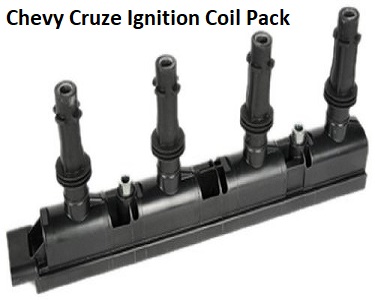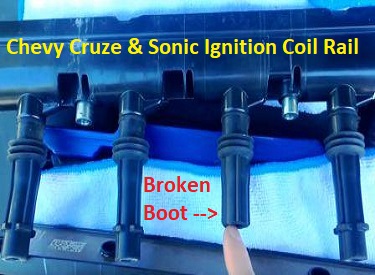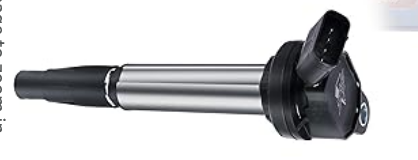Chevy Ignition Coil Problem
The best way to sidestep the ignition coil problem on a Chevy is to not touch it. Most people run into this issue when they attempt to replace the spark plugs on their Chevrolet Spark and Cruze models.
After making my rounds and doing some research I find a large misconception about when to replace these maintenance items.
According to the official simplified maintenance guide from Chevrolet, these spark plugs will not require replacement until the vehicle reaches 97,500 miles.This is amazing, but I've found they can go even further than that.
In fact, I recommend leaving things alone unless you have a rough running engine. Of course, if you’re setting misfire check engine light codes then you won't be able to wait.
We'll talk more about this issue in the ignition coil symptoms section below. Also included in this brief article covering the problem, we'll discuss the repair procedure.
You can get super cheap parts from Amazon and save big dollars over the dealership route. However, I'm not a fan of the super cheap parts from you know where.
I go for the AC delco replacement parts on Amazon. Personally I've just had better luck. Either way, I wish you well with the repairs.
 Chevy Cruze Ignition Rail
Chevy Cruze Ignition RailUnlike the coolant leak in the Chevrolet Cruze the ignition coil makes an excellent first time do-it-yourself auto repair.
For this reason, we'll include the two inexpensive tools you might want to pick up before you start the operation. Hint: you need a Torx 30 size socket to remove the ignition coil.
Why the Chevrolet Ignition Coil Fails

The ignition coil pack can suffer from increased internal resistance. Failed factory completed electromagnetic primary and secondary winding connection problems can also happen.
With that said, the assembly see's high heat temperatures in the valley of the valve cover. As we learned in science class, heat rises and the rubber and plastic components will eventually fail and cause us trouble.
Therefore, the main reason why the coil fails is because it doesn't want to come out. More specifically, the rubber boot gets fused to the ceramic portion of the spark plugs.
If I’m fortunate enough to reach you before breaking the boot, you might be able to stop this from happening.
This is another reason I stress, you shouldn't replace the spark plugs until they reach their recommended maintenance interval of 97,500 miles. Since the tune-up costs you an extra $110 if you rip or break a spark plug boot, why do it early?
Sidebar: Chevrolet let us down here. When manufacturers apply liberal amounts of dielectric grease to the inside surface of the spark plug boots it stops it from sticking to the porcelain of the spark plugs.
On the Chevrolet 4 cylinder engines I've worked on, I see, in some cases only a small amount of this tune up grease. In other words, they skimped on this probably to save money.
With that said, sometimes owners of the Chevrolet Cruze are forced to replace the spark plugs earlier than the recommended maintenance mileage.
Sometimes the spark plugs wear out prematurely. Then you experience a rough idle, bucking, poor fuel economy and a lack of power.
All of these symptoms stem from a spark plug not firing correctly. As you can imagine, if you have a four-cylinder engine with one or more cylinders malfunctioning the problem needs dealing with right away.
When these engines misfire on one or more cylinders they set check engine light computer trouble codes.
The random misfire code is P0300. If an individual cylinder misfires it sets a designated code for that hole. Example, if the number one cylinder misfires it sets a code P0301. If number 2 cylinder is the one with the issue it sets a code P0302.
If you let this misfire situation continue you can eventually damage the catalytic convertor. In an engine misfire scenario, the cylinder with the problem allows raw fuel to enter the exhaust system. This will eventually damage the catalytic convertor.
In other words, don't try to limp the car along or put off the repairs.
How to Remove the Ignition Coil
The ignition coil is under a small plastic panel on the center of the valve cover. This plastic panel says Ecotec on it. It's held on by pressure clips and snaps off.
From a tools point of view you'll need a Torx number 30 size bit to remove the two retaining bolts from the coil. If you're replacing the spark plugs you'll need a 5/8 size spark plug socket.
If you're reading this before you attempted to remove the ignition coil congratulations. There’s a chance that you can get the coil pack assembly out without breaking the boot.
However, don't feel bad if you do rip a boot, because I've done it a few times myself. Sometimes it just won't come loose.
More of the wiggling then the upward pulling become necessary to work the boots loose. A quick note about the electrical connector. There is a red safety lock that stops the connection from coming loose.
You need to slide the lock to the left before pushing down on the release button. You don't want to break this electrical connector.
Although there's a lot of videos on how to replace the Chevy ignition coil I see they missed some critical steps recommended by professional mechanics. After you get the coils off of the spark plugs you'll see they fit down deep inside of a tunnel.
Before you remove the spark plugs you need to try and blow any dirt or sand out from around the spark plug. How much collects really depends on the driving conditions in your area.
Since you probably don't have a shop compressor, you can use those compressed air dusters for computers in a pinch.
If you decide to try and save a few bucks I recommend a coil assembly from a reputable supplier that will exchange the coil if they send you one that doesn't work. In addition, look for coil assemblies that have a metal heat shield that protects the spark plug boots.
Before you Install the New Coil Pack
I have a couple of notations to think about before you reinstall the ignition coil pack. The original spark plugs lasted about 97,000 miles.
If you replace these with Iridium high performance spark plugs you'll probably never have to do the job again.
One more thing about these four-cylinder spark plugs, they thread into an aluminum cylinder head.
Don't crush them when you tighten it down, because you can damage the cylinder head threads by over tightening them.
If you decide to go with the cheaper two dollar plugs make sure you get some dielectric tune up grease. This stuff also keeps moisture out.

Try using a small detail paintbrush to apply a liberal coating inside of the coil to spark plug boots. This is what the factory should’ve done in the first place. But I digress.
Nevertheless, it should provide you the edge you need to remove the ignition coil rail assembly without breaking the fragile boots on the next tune up and maintenance interval.
If you're reading this and you know somebody with a Chevrolet Cruze, do them a favor and point them to this page so they can learn about the situation before they attempt to replace the spark plugs for the first time.
Author bio : Mark is a retired ASE certified master technician, Chevrolet Professional Service Council member and the founder of FixMyOldRide.com. Watch the video on the about Mark the mechanic page to see his credentials, awards and certifications for yourself. Mark hand writes all of the articles on FixMyOldRide.com unless indicated otherwise.